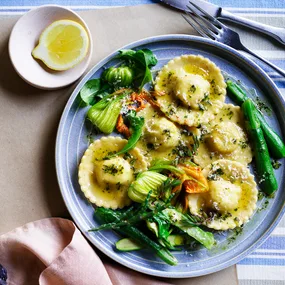Just about every culture has some kind of skewered meat cooked over charcoal, from Japanese yakitori to Portuguese espetadas – pretty much anyone who had meat, fire and a stick gave it a go. In Turkey, where we call them kebaps, there are more than a hundred versions, from the familiar doner kebap (often misrepresented here in Australia) and the Adana kebap to lesserknown types using chicken, livers, sweetbreads, and small fish.
Every city has its own version, but Adana in the south and nearby Gaziantep each claim to be the capital of kebaps. I don’t side with either rival – I love both cities and visit them frequently – so the recipe here uses Adana-style meat in a Gaziantep-style dish.
In Gaziantep, the ali nazik kebap, refined over centuries, combines four Turkish staples: lamb, eggplant, peppers and yoghurt.
The classic Adana kebap, meanwhile, uses five parts lamb belly or rib meat and one part tail fat, from a male lamb, with sweet red bullhorn peppers, paprika and salt. I’ve found just one butcher in Sydney who sells lamb tail fat, and I travel quite a distance – like most good Middle Eastern ingredients in Sydney, it’s found in the outer western suburbs – to buy his product to use in our kebabs at Efendy. So, since it’s next to impossible to find tail fat, I’ve used fatty lamb belly here, removing just the fat cap.
In traditional kebap houses, the meat is hand-cut with a sword-like knife called a zirh. And yet it’s a delicate skill. When choosing an apprentice, a kebap master would put a piece of paper between the chopping board and the lamb and ask the candidate to mince the meat using a zirh.
If there were no cuts in the paper, the candidate had the job. An easier alternative is to get your butcher to mince it for you.

Step 3.
You’ll need large, wide metal skewers, available from Middle Eastern and Turkish grocers. Otherwise, simply make köfte, with no need for skewers, forming the meat into small sausages. Or make even smaller balls and cook them on bamboo skewers to serve as an appetiser.
It’s important to get the consistency of the meat right so it stays on the skewers. Chop the meat as finely as you can so you have even marbling of fat and meat, then knead the mixture (which aids binding) until you can pick it up in one giant ball; being quite forceful helps the meat glue together. If you’re making köfte, work the meat even further by slapping it against the bowl; this can also be done in an electric mixer fitted with a paddle attachment.

Step 4.
When shaping the kebaps, press the meat firmly around the skewer to seal it, particularly at the ends. I make a chilli water to dampen my hands while doing this (it also adds extra seasoning). As the meat cooks, when you see it lifting from the skewer, gently turn the skewer over. The first two turns are the most important; once the meat has started cooking evenly it will be more stable.

Step 6.
We serve our kebaps with an eggplant yoghurt purée. I use pot-set yoghurt.
Contrary to popular belief, a good yoghurt should not be shiny, and the whey should be visible. For this dish I hang the yoghurt overnight to strain out the whey for a denser, creamier yoghurt.
Barbecue the kebaps over low embers, not flames; light the barbecue at least an hour beforehand and put the kebabs on once the charcoal is coated with ash. Dripping fat can cause the embers to flare up; just throw a bit of salt on the fire to contain the flames.
The translation of ali nazik is “gentle Ali”, as though it were made by a kebap master named Ali. It’s more likely a corruption of “eli nazik”, or gentle hands. Regardless, it’s one of the best kebaps I’ve had and it has been a favourite on our menu at Efendy since 2012, so enjoy and bon appétit – or, as we say in Turkey, afiyet olsun.
.gif?resize=877%2C1024)
The recipe
30 mins preparation | 25 mins cooking
Serves 6
Start this recipe a day ahead to hang the yoghurt.
Ingredients
Method
Note Aleppo pepper is available from Turkish grocers and Herbie’s Spices (herbies.com.au); if it’s unavailable substitute another ground chilli. Large flat skewers, ideally 2cm wide, are available from Turkish grocers. If you’re making köfte, roll the meatballs into small sausages in the palm of your hand and flatten slightly; grill on a rack or the flat-top of your barbecue. Small rectangular barbecues, available from Turkish and Middle Eastern grocers, are designed for holding skewers on the sides; if you have a large conventional barbecue, place bricks on the sides as rests for the skewers.
Notes
 Rob Shaw
Rob Shaw









